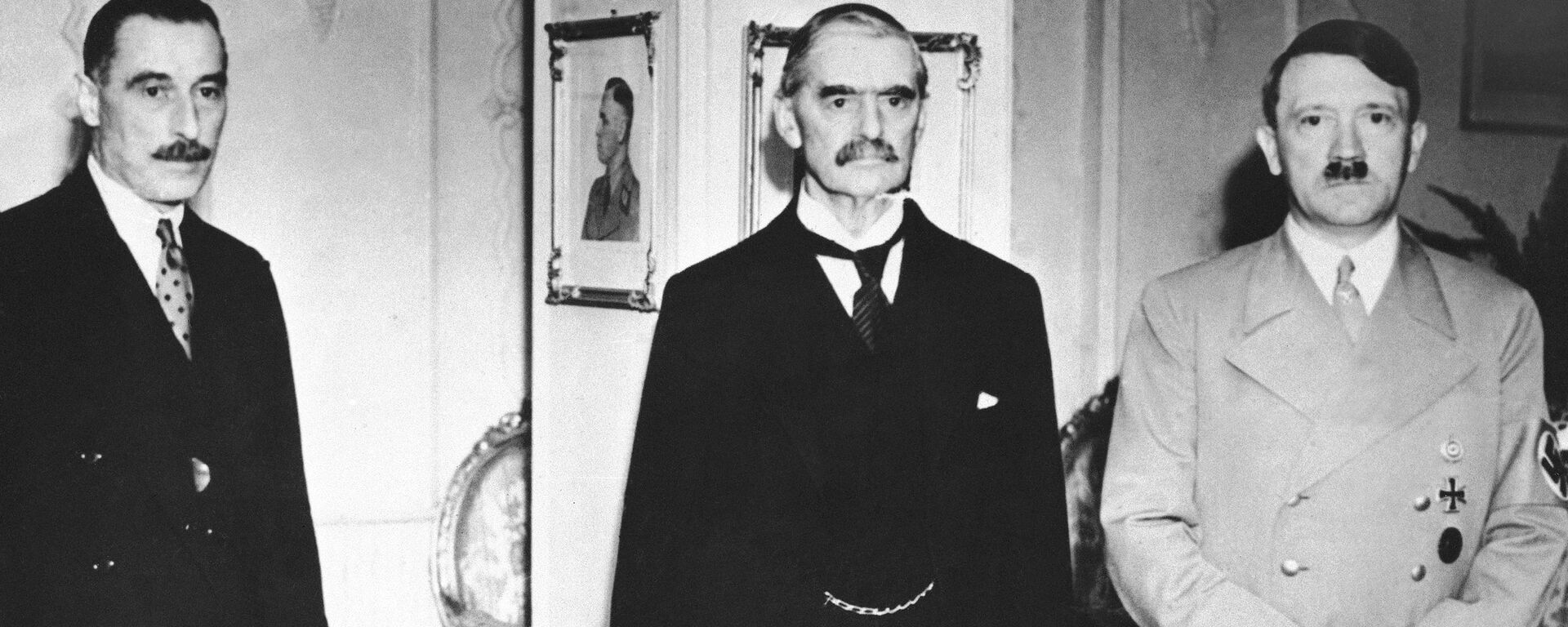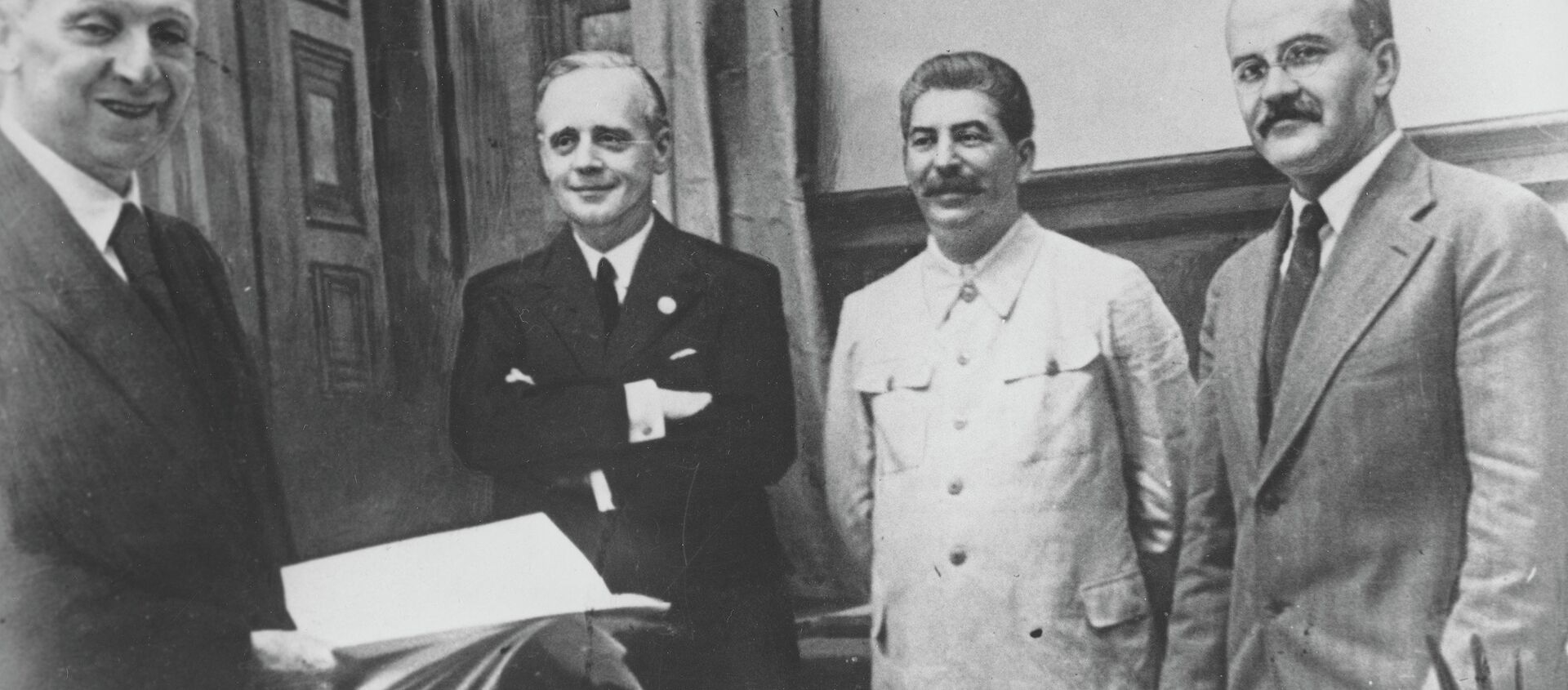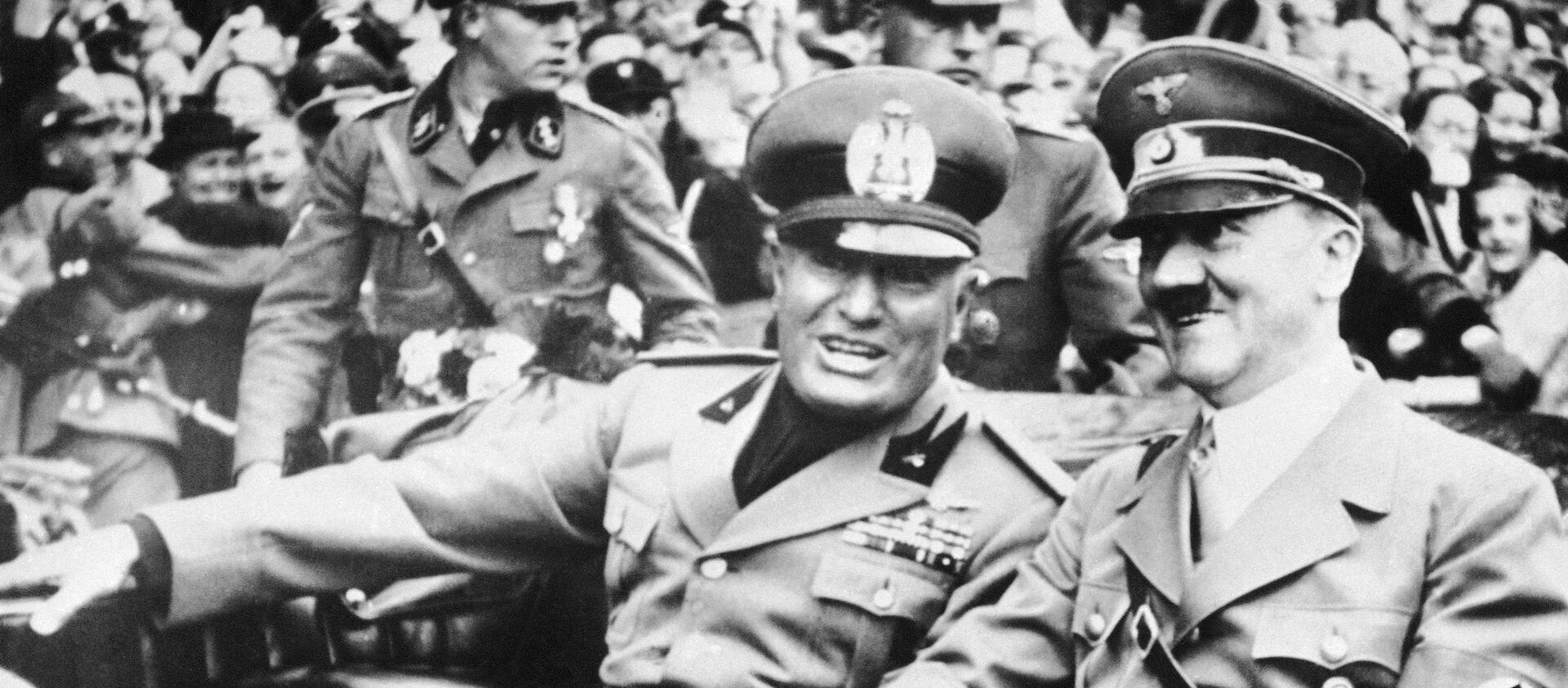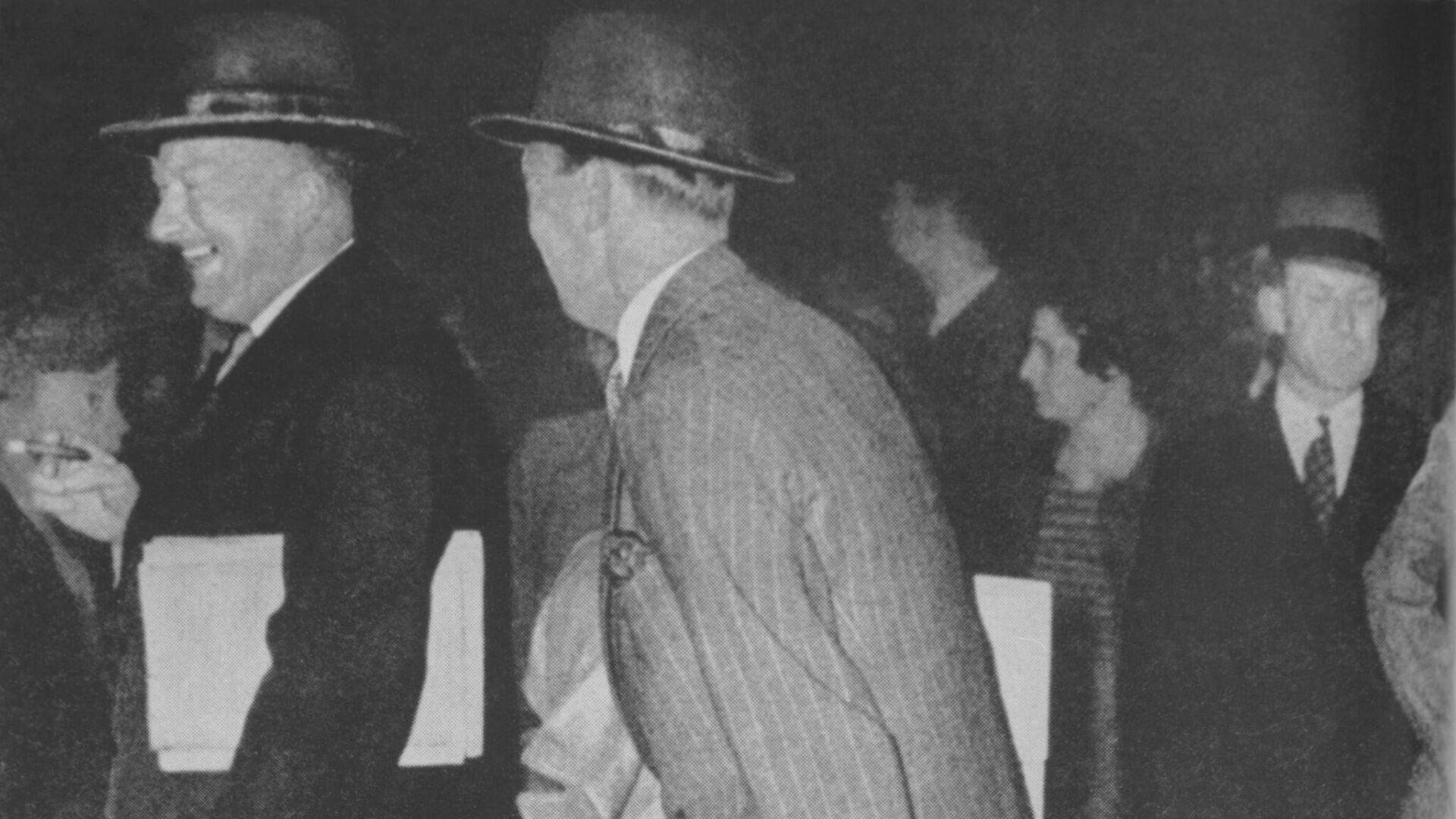https://sputnikglobe.com/20230106/declassified-doc-reveals-how-uk-france-tried-to-whitewash-responsibility-for-wwii-1106090510.html
Declassified Doc Reveals How UK, France Planned to Whitewash Responsibility for WWII
Declassified Doc Reveals How UK, France Planned to Whitewash Responsibility for WWII
Sputnik International
Over 80 years since the start of World War II, debates continue to rage about who is responsible for the deadliest conflict in history.
2023-01-06T19:10+0000
2023-01-06T19:10+0000
2023-05-07T18:35+0000
world
world war ii
joseph stalin
adolf hitler
neville chamberlain
negotiations
talks
diplomatic relations
diplomacy
https://cdn1.img.sputnikglobe.com/img/07e7/01/06/1106090363_0:0:2049:1153_1920x0_80_0_0_45c214b300ac5974f921d914c16ec876.jpg
Months after the start of the Second World War, the United Kingdom and France planned to release a blue book collection of doctored diplomatic correspondence to try to paint the USSR as the party responsible for the breakdown of the Soviet-Anglo-French defense pact talks of the summer of 1939.A document dated January 27, 1940, citing information provided by an undercover agent inside Her Majesty’s Government, published in the Russian Foreign Intelligence Service’s digital archive, detailed plans by the British to release the blue book, and its expected contents.“This book will consist of a number specially selected and falsified ‘documents’, which, in the view of London, will prove to the world that while ‘the English honestly negotiated with the USSR and intended to conclude a pact, the Bolsheviks played a double game, signing the Soviet-German agreement and unleashing a European war’,” the document reads.The agent characterized the task before the blue book’s curators as a “hefty” one, given the need “to prove that white is black and in general to turn everything upside down.”Soviet, British and French negotiators held talks in Moscow in the summer of 1939 in a last-ditch attempt to create a Soviet-Anglo-French triple alliance against Adolf Hitler’s Germany, which by that point had annexed Austria, the Sudetenland, the rest of Czechoslovakia and set its sights on Poland’s Danzig corridor.The talks began after months of stalling by British Prime Minister Neville Chamberlain, who signaled a “profound distrust of Russia” and balked at the idea of an alliance with Moscow despite indications by Joseph Stalin of readiness to entertain such an ‘unholy alliance’ of Western bourgeois democracies and the socialist Soviet Union. In the years leading up to 1939, Moscow accused Chamberlain, his French allies and US industrialists of assisting in Hitler’s rise, and seeking to maneuver him into a war with the USSR.During their talks in the summer of 1939, Soviet, British and French negotiators tentatively agreed to provide military assistance to Germany’s neighbors in the event of aggression, but London refused to pressure its Polish allies to allow Red Army troops in to help in defense in the event of aggression. Relations between Warsaw and Moscow remained hostile throughout the interwar period due to the Polish-Soviet War of 1919-1921, during which Warsaw bit off big chunks of Ukrainian and Belarusian territory from the fledgling Soviet state.When it came time for military-to-military negotiations, the tripartite talks immediately collapsed, with Britain and France diplomatically slapping Soviet Defense Minister Kliment Voroshilov in the face by sending minor military officials unauthorized to make any decisions to speak with him. When Voroshilov asked the negotiators point blank whether Poland and Romania would allow Red Army troops through to fight the Nazis in the event of aggression by Berlin, they shrugged and said they weren’t competent to answer this question, with talks broken off on August 21, 1939.Just days later, Soviet Foreign Minister Vyacheslav Molotov and German Foreign Minister Joachim von Ribbentrop signed the Molotov-Ribbentrop non-aggression pact, setting the stage for Hitler’s invasion of Poland.The blue book referred to in the declassified Soviet intelligence document was supposed to have come out in December 1939, but its publication was delayed, first to be cleared by William Seeds, the short-lived British Ambassador to the Soviet Union, who participated in the summer negotiations.Mädchen was one of the code names used by Guy Burgess of the Cambridge Five. At the time the document was published, Burgess was working in British intelligence, and enjoyed regular contacts with senior government officials. The spy’s information proved crucial in helping the Soviet leadership assess London’s true intentions behind the smokescreen of negotiations. During the fateful summer of 1939 talks in Moscow, Burgess informed Soviet officials that Britain had no intention to actually signing a defense pact, influencing Stalin’s calculated move of negotiating a non-aggression pact with Hitler to buy Moscow time to rearm and prepare for a major European war.According to the document, another source, whose name was curiously redacted, shared “roughly the same” information as Agent Mädchen on the existence of this draft blue book, one of them said to be in contact with “Halifax,” –presumably Lord Halifax, Britain's ambassador to the United States.The Blue Book’s publication was ultimately scrapped, with the Nazis overrunning France in the summer of 1940 and kicking the British Expeditionary Forces off the mainland.The winter of 1939-1940 proved the tensest period in relations between the USSR and the Western Allies, with London and Paris considering a direct military intervention to fight the Soviets during the Winter War in Finland, and making plans to bomb Soviet oil fields in Azerbaijan. It took the Nazi occupation of almost the whole of continental Europe, and the invasion of the Soviet Union in June 1941, to get Moscow and London to return to the idea of an alliance against Berlin.
https://sputnikglobe.com/20150926/1027577179.html
https://sputnikglobe.com/20150823/molotov-ribbentrop-pact-untold-story-1026098760.html
https://sputnikglobe.com/20171006/nobel-prize-hitler-mussolini-1057997560.html
Sputnik International
feedback@sputniknews.com
+74956456601
MIA „Rosiya Segodnya“
2023
News
en_EN
Sputnik International
feedback@sputniknews.com
+74956456601
MIA „Rosiya Segodnya“
Sputnik International
feedback@sputniknews.com
+74956456601
MIA „Rosiya Segodnya“
world war ii, negotiations, talks, diplomatic blue book, documents, declassified
world war ii, negotiations, talks, diplomatic blue book, documents, declassified
Declassified Doc Reveals How UK, France Planned to Whitewash Responsibility for WWII
19:10 GMT 06.01.2023 (Updated: 18:35 GMT 07.05.2023) Over 80 years since the start of World War II, debates continue to rage about who is responsible for the deadliest conflict in history. Western officials and historians blame the USSR, citing the signing of the Soviet-German non-aggression pact. Revisionists contest this narrative, pointing to the British, French and US roles in Hitler’s rise.
Months after the start of the Second World War, the United Kingdom and France planned to release a blue book collection of doctored diplomatic correspondence to try to paint the USSR as the party responsible for the breakdown of the Soviet-Anglo-French defense pact talks of the summer of 1939.
A document dated January 27, 1940, citing information provided by an undercover agent inside Her Majesty’s Government, published in the Russian Foreign Intelligence Service’s
digital archive, detailed plans by the British to release the blue book, and its expected contents.
“This book will consist of a number specially selected and falsified ‘documents’, which, in the view of London, will prove to the world that while ‘the English honestly negotiated with the USSR and intended to conclude a pact, the Bolsheviks played a double game, signing the Soviet-German agreement and unleashing a European war’,” the document reads.
The agent characterized the task before the blue book’s curators as a “hefty” one, given the need “to prove that white is black and in general to turn everything upside down.”
Soviet, British and French negotiators held talks in Moscow in the summer of 1939
in a last-ditch attempt to create a Soviet-Anglo-French triple alliance against Adolf Hitler’s Germany, which by that point had annexed Austria, the Sudetenland, the rest of Czechoslovakia and set its sights on Poland’s Danzig corridor.

26 September 2015, 12:55 GMT
The talks began after months of stalling by British Prime Minister Neville Chamberlain, who signaled a “profound distrust of Russia” and
balked at the idea of an alliance with Moscow despite indications by Joseph Stalin of readiness to entertain such an ‘unholy alliance’ of Western bourgeois democracies and the socialist Soviet Union. In the years leading up to 1939, Moscow accused Chamberlain, his French allies and US industrialists of assisting in Hitler’s rise, and seeking to maneuver him into a war with the USSR.
During their talks in the summer of 1939, Soviet, British and French negotiators tentatively agreed to provide military assistance to Germany’s neighbors in the event of aggression, but London refused to pressure its Polish allies to allow Red Army troops in to help in defense in the event of aggression. Relations between Warsaw and Moscow remained hostile throughout the interwar period due to the Polish-Soviet War of 1919-1921, during which Warsaw bit off big chunks of Ukrainian and Belarusian territory from the fledgling Soviet state.
When it came time for military-to-military negotiations, the tripartite talks immediately collapsed, with Britain and France diplomatically slapping Soviet Defense Minister Kliment Voroshilov in the face by sending minor military officials unauthorized to make any decisions to speak with him. When Voroshilov
asked the negotiators point blank whether Poland and Romania would allow Red Army troops through to fight the Nazis in the event of aggression by Berlin, they shrugged and said they weren’t competent to answer this question, with talks broken off on August 21, 1939.
Just days later, Soviet Foreign Minister Vyacheslav Molotov and German Foreign Minister Joachim von Ribbentrop signed the Molotov-Ribbentrop non-aggression pact, setting the stage for Hitler’s invasion of Poland.

23 August 2015, 16:01 GMT
The blue book referred to in the declassified Soviet intelligence document was supposed to have come out in December 1939, but its publication was delayed, first to be cleared by William Seeds, the short-lived British Ambassador to the Soviet Union, who participated in the summer negotiations.
“After his arrival [in the UK] and after looking through the book, it nevertheless has yet to see the light of day. According to the information of [Agent] Mädchen, the publication of the book has been postponed until the end of January or the start of February. The reason behind the delay is allegedly related to the persistent desire of the French to make the book more anti-Soviet than its original draft. Furthermore, the French have supposedly discovered that in the original version, the British failed to whitewash the Poles over their role in breaking off the Anglo-Soviet negotiations,” the report’s unnamed author wrote.
Mädchen was one of the code names used by Guy Burgess of the
Cambridge Five. At the time the document was published, Burgess was working in British intelligence, and enjoyed regular contacts with senior government officials. The spy’s information proved crucial in helping the Soviet leadership assess London’s true intentions behind the smokescreen of negotiations. During the fateful summer of 1939 talks in Moscow, Burgess informed Soviet officials that Britain had no intention to actually signing a defense pact, influencing Stalin’s calculated move of negotiating a non-aggression pact with Hitler to buy Moscow time to rearm and prepare for a major European war.
According to the document, another source, whose name was curiously redacted, shared “roughly the same” information as Agent Mädchen on the existence of this draft blue book, one of them said to be in contact with “Halifax,” –presumably Lord Halifax, Britain's ambassador to the United States.

6 October 2017, 07:52 GMT
The Blue Book’s publication was ultimately scrapped, with the Nazis overrunning France in the summer of 1940 and kicking the British Expeditionary Forces off the mainland.
The winter of 1939-1940 proved the tensest period in relations between the USSR and the Western Allies, with London and Paris considering a direct military intervention to fight the Soviets during the Winter War in Finland, and making plans to bomb Soviet oil fields in Azerbaijan. It took the Nazi occupation of almost the whole of continental Europe, and the invasion of the Soviet Union in June 1941, to get Moscow and London to return to the idea of an alliance against Berlin.







